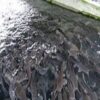- このトピックは空です。
- 投稿者投稿
- 3月 19, 2025 6:55 pm #598163

Optimizing catfish growth and health hinges significantly on proper nutrition, a process where the catfish feed size chart plays a pivotal role.
This tool provides guidelines for selecting the appropriate feed pellet size, ensuring efficient consumption and minimizing waste. The importance of this seemingly simple chart cannot be overstated, as it directly impacts the overall productivity and sustainability of catfish farming.
1. Optimizing Feed Consumption
A catfish feed size chart helps match the feed pellet size to the fish’s mouth size, ensuring that they can easily consume the feed. Smaller pellets are suitable for fry and fingerlings, while larger pellets are necessary for mature catfish.
This optimization prevents fish from struggling to eat or rejecting the feed, leading to better feed conversion ratios and faster growth. Matching pellet size to fish size ensures less wasted feed as well.
2. Enhancing Digestive Efficiency
Proper feed size significantly impacts the digestive process. Catfish, like other fish, have digestive systems adapted to specific particle sizes. A catfish feed size chart guides farmers in selecting feed that can be efficiently processed, maximizing nutrient absorption.
This reduces the risk of digestive issues and improves overall fish health. The correct feed size prevents blockages in the digestive tract, ensuring nutrients are properly absorbed.
3. Minimizing Feed Waste
Using the correct feed size as indicated by a catfish feed size chart minimizes feed waste. When pellets are too large, young fish may struggle to consume them, leading to uneaten feed settling at the bottom of the pond.
Excess feed contributes to water pollution and can negatively impact water quality. Conversely, overly small pellets for larger fish might be ignored, also leading to waste.
4. Promoting Uniform Growth
A well-structured feeding regimen based on a catfish feed size chart contributes to uniform growth within the catfish population. Providing appropriately sized feed ensures that all fish can access and consume the necessary nutrients.
This reduces competition for food and helps prevent size disparities, leading to a more consistent harvest. The use of the chart ensures that all fish are getting the required nutrition for their specific growth stage.
5. Supporting Water Quality
Improper feeding practices can lead to excess organic matter accumulating in the pond, affecting water quality. A catfish feed size chart helps prevent overfeeding and ensures that feed is efficiently consumed. This reduces the risk of ammonia and nitrite buildup, which can be harmful to catfish. Proper feed utilization contributes to a healthier aquatic environment.
The effectiveness of catfish farming is significantly enhanced by the careful application of a catfish feed size chart. It ensures optimal feed consumption, digestive efficiency, minimal waste, uniform growth, and improved water quality.
By adhering to the guidelines provided by this chart, farmers can maximize productivity and sustainability in their aquaculture operations.
Read Also: The Quest for Rapid Growth: A Look at Catfish Farming Enhancements
- 投稿者投稿
- このトピックに返信するにはログインが必要です。






